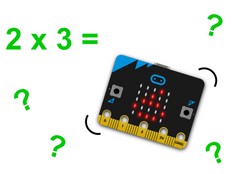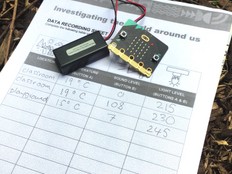Cam 1: Gwneud
Beth yw e?
Use your BBC micro:bit to measure distances as you walk.
Beth fyddwch yn ei ddysgu
This practical project shows how to use multiplication and variables to measure distances.
Sut mae'n gweithio
- Mae'r rhaglen hon yn cyfrifo pellteroedd trwy luosi hyd cam â nifer y camau a gymerwch. It uses an average child's step length of 0.6 metres.
- Carefully walk the distance you want to measure, pressing button A each time you take a step.
- The program works by increasing the 'step count' variable by one each time button A is pressed.
- Press button B to see the distance you have walked in metres. The micro:bit calculates this by multiplying the 'step count' variable by the step length.
- If you want to know how many steps you took, press the touch logo on the front of your micro:bit.
- Reset the micro:bit by pressing the reset button on the back.
Beth sydd ei angen arnoch
- BBC micro:bit and battery pack
Cam 2: codio
1# Imports go at the top
2from microbit import *
3import music
4
5stepcount = 0
6steplength = 0.6
7display.show(0)
8music.play(['c4:4'])
9
10while True:
11 if button_a.is_pressed():
12 music.play(['c3:2'])
13 display.show(Image.HEART)
14 sleep(400)
15 stepcount += 1
16 display.clear()
17 if button_b.is_pressed():
18 display.scroll(stepcount*steplength)
19 if pin_logo.is_touched():
20 display.scroll(stepcount)Cam 3: gwella
- Calculate your average step length in metres and use it to replace the 0.6 number in the code.
- Calculate areas of rectangles, such as parts of a school playground, by measuring each side and multiplying the distances together.
- Add cardboard to make the buttons easier to press, as seen in the Improve it section of the Emotion badge project.
- Use this wheelchair distance calculator code that can automatically detect when your wheel rotates. Replace the 0.6 number with the circumference of your wheel measured in metres.
This content is published under a Creative Commons Attribution-ShareAlike 4.0 International (CC BY-SA 4.0) licence.


